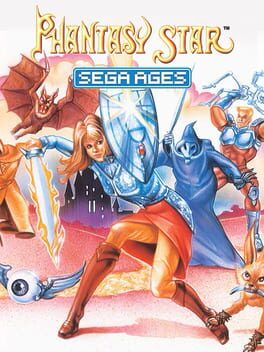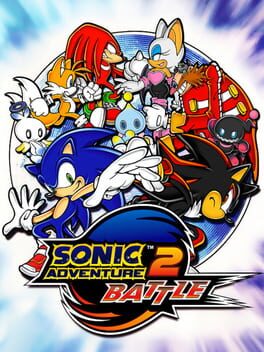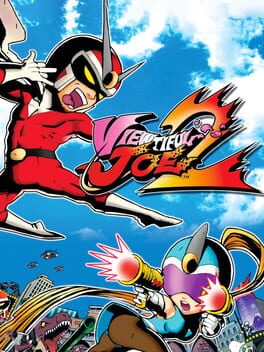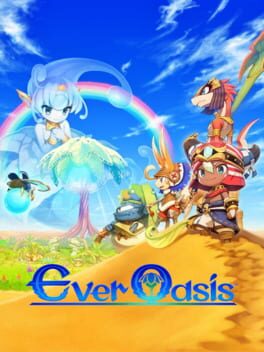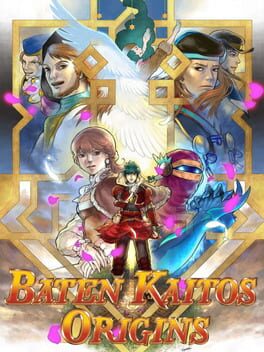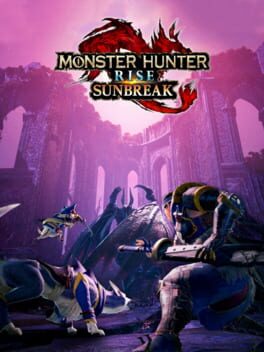ULF
Throughout Ages mode Phantasy Star 1 was mostly a nice and brisk adventure with decent enough play duration for the game not to wear out its welcome.
The item descriptions and ingame maps for the maze dungeons adds much levity to the experience and aside from a few spots the puzzles and open-structure exploration is very solid.
Although having only two inn areas bogged the pacing down a bit, with some repetitious backtracking.
I'm glad I finally got around to playing it, and really looking forward to the later entries in the series.
The item descriptions and ingame maps for the maze dungeons adds much levity to the experience and aside from a few spots the puzzles and open-structure exploration is very solid.
Although having only two inn areas bogged the pacing down a bit, with some repetitious backtracking.
I'm glad I finally got around to playing it, and really looking forward to the later entries in the series.
Built from the same engine as its predecessor, Adventure 2 made its way jam packed with the equal formula of diversifying gameplay styles into a more linear narrative with dank, edgy and so cheesy it's good vibe tale of good and evil goes to space and Knuckles.
The added score system ties itself into the three seperate styles of gameplay in different ways but generally in how you perform in stages by doing small tricks, chaining comboes, time bonuses. It feels awesome when you nick a good chunk of points, but can be pretty demotivating when you get low ranks.
On replays I really enjoy trying to go for good ranks and aestetically Sonic Adventure 2 feels like a very arcade authentic game of grabbing good scores while the story mode itself isn't particulary long either. It's well paced and very dynamic.
As for completion and getting all the emblems now that is another story, this can easily rack up the gameplay time for another 60-70 hours of completing all the challenges for emblems, as well as going into the tamagotchi inspired chao garden of pretty insane depth and mundane, but oddly addictive grinding.
I still think Sonic Adventure 2 has the best and most addictive/rewarding ranking system in the series and while there are a short few couple of stages that are borderline awful, the great ones stands as some of the best in the franchise and the Sonic/Shadow stages are a pure delight of thrill and challenge with an incredible sense of speed.
Adventure 2 is at times more challenging than SA 1, but also a blast to play especially when you get better at it.
The added score system ties itself into the three seperate styles of gameplay in different ways but generally in how you perform in stages by doing small tricks, chaining comboes, time bonuses. It feels awesome when you nick a good chunk of points, but can be pretty demotivating when you get low ranks.
On replays I really enjoy trying to go for good ranks and aestetically Sonic Adventure 2 feels like a very arcade authentic game of grabbing good scores while the story mode itself isn't particulary long either. It's well paced and very dynamic.
As for completion and getting all the emblems now that is another story, this can easily rack up the gameplay time for another 60-70 hours of completing all the challenges for emblems, as well as going into the tamagotchi inspired chao garden of pretty insane depth and mundane, but oddly addictive grinding.
I still think Sonic Adventure 2 has the best and most addictive/rewarding ranking system in the series and while there are a short few couple of stages that are borderline awful, the great ones stands as some of the best in the franchise and the Sonic/Shadow stages are a pure delight of thrill and challenge with an incredible sense of speed.
Adventure 2 is at times more challenging than SA 1, but also a blast to play especially when you get better at it.
1996
Piloting your way to that perfect score praying you can pull of that landing with the right criterias fulfilled while poking both middlefingers up to the skies as you get that zero point reward for landing impact. That is pilotwings 64. An otherwise utterly charming launch title for the N64 that flexed with what the system had to offer through its detailed and atmospheric playground and diverse mechanics.
So much nostalgia and still in awe for the cool little details spread around the isles, while vibing to those good jazzy synths eluded some of the pain of the later challenges. Hang glider can kiss my ass, jetpack and helicopter are pretty cool. And the unlockable extra vehicles/modes and challenges are all enjoyable as long as they last.
It's very short, but varied, some challenges more fun than others, both infuriating and rewarding to master due to how picky the score system is, but it has delightfully cozy vibes and was a pretty mindblowing game to experience back at launch.
So much nostalgia and still in awe for the cool little details spread around the isles, while vibing to those good jazzy synths eluded some of the pain of the later challenges. Hang glider can kiss my ass, jetpack and helicopter are pretty cool. And the unlockable extra vehicles/modes and challenges are all enjoyable as long as they last.
It's very short, but varied, some challenges more fun than others, both infuriating and rewarding to master due to how picky the score system is, but it has delightfully cozy vibes and was a pretty mindblowing game to experience back at launch.
1998
Strong vibes, excellent narration and solid 16 bit jrpg adventuring with an overall difficulty curve just on the right spot..for the most parts.
Personally I feel like the story started of stronger than it ended up with, but the cartoon styled cutscenes were super cool and plentiful, while the pacing never dropped throughout its 20 or so hour run.
The inventory menu is easily the weakest aspect with zero item/ gear stat or spell descriptions, and there are A LOT of spells and skills to keep track of, so holding a sheet with descriptions on the side is absolutely essential to play through this.
While dungeons are a lot easier to traverse than Phantasy Star II, they still have no checkpoints, so if you game over it's straight back to the title screen.
Phantasy Star 4 also loves throwing gimmick bosses at you, so be ready to suddenly get wiped because you didnt use a requisite item or weapon.
Even with its share of flaws and less intuitive design choices, it's still a fantastic jrpg worth the trouble.
Personally I feel like the story started of stronger than it ended up with, but the cartoon styled cutscenes were super cool and plentiful, while the pacing never dropped throughout its 20 or so hour run.
The inventory menu is easily the weakest aspect with zero item/ gear stat or spell descriptions, and there are A LOT of spells and skills to keep track of, so holding a sheet with descriptions on the side is absolutely essential to play through this.
While dungeons are a lot easier to traverse than Phantasy Star II, they still have no checkpoints, so if you game over it's straight back to the title screen.
Phantasy Star 4 also loves throwing gimmick bosses at you, so be ready to suddenly get wiped because you didnt use a requisite item or weapon.
Even with its share of flaws and less intuitive design choices, it's still a fantastic jrpg worth the trouble.
2004
1994
Everything the light touches is our kingdom!
This was my favourite dos game back in the 90's, the majestic pc-dos soundtrack jingling tunes straight from the movie as the occasionally brutal, yet vibrant and diverse levels sets the tone just right as individual set pieces to our beloved tale.
Challenging and occasionally cheap (looking at you level 2), but at the same time forgiving enough with 1 ups and continues generously scattered about, increasingly so as you get to the final stretch of this otherwise short and bittersweet platformer.
This was my favourite dos game back in the 90's, the majestic pc-dos soundtrack jingling tunes straight from the movie as the occasionally brutal, yet vibrant and diverse levels sets the tone just right as individual set pieces to our beloved tale.
Challenging and occasionally cheap (looking at you level 2), but at the same time forgiving enough with 1 ups and continues generously scattered about, increasingly so as you get to the final stretch of this otherwise short and bittersweet platformer.
2023
Before the launch of XVI the excitement seemed common as the demo dropped its introductory story chapters with a bag of promises for good things to come. And then there were tides a-coming hoo boy.
Even from where I stand with my verdict, it is fairly safe to say that no matter what you would think of XVI, past the demo chapters the narrative takes a plunge in a direction that can be hard to endourse.
With one of XVI's central thematics of staying with the present and keeping the past at your back, this carries strongly over to a narrative that takes both its time and duller moments to suddenly sweep through its story hardly reflecting back on itself as both central and side characters come and go, while the main character Clive Rosfield is the one you always share eyes and toes with as he stands on his own character and makes his bond with others.
It's tough to negotiate how to take the narrative's handling with its character building, and while you could argue that some characters are unproperly treated and left for dirt, there is also a touching bond and growth amongst the cast that sticks together towards the amazing final showdown.
Among some stupifying and dull moments there are such grand moments of excellence that makes the bag of goods utterly hard to value by one current, unless you're like me and hang on to the parts that you can always look forward to.
While sharing recurring elements from it's franchise XVI is an entirely different mechanically driven game, similar to other beat them ups made by Platinum along with its share of jrpg stats and gear elements to keep the momentum going as you progress. The combat is very easy to get into with its linear combo system and slightly diversing range of abilites you gain throughout the story, while parrying and positioning plays the central element particularily for the bigger enemies dps bursting out with special abilities whenever you can.
In structure XVI is built on a very handholdy and linear chapter focused narrative, while there are also cities and maps to explore with sidequests that will keep you busy per chapters.
It is all very streamlined to the degree that there's always directional guides of where to go, with the exception of the bounty board sidequesting gradually dishing out optional bossfights scattered around the world maps that you have to look for on your own. While some of these are just recycled buffed up monsters they were a pretty fun side endevour overall, although the difficulty generally is less likely to drive you up the walls, XVI is without a doubt the EASIEST Final Fantasy ever made.
That is, at least until you unlock hard mode after beating the game, which honestly is a weird toggle to unlock for a 60 hour run game, but what can you do?
The strongest moments lies in the main story chapter portions and incredible eikon boss fights, while the
sidequests for the most parts play themselves over each other, be it either fetch or hunting down some monsters alongside the majority of dialogues happening through glaringly cheap stock animated cutscenes.
I will say though that the sidequests builds on pretty much EVERY character in the game, so if you omit any, it may even kill away some character context for the later chapters.
Even if some of it can be incredibly dull and feel empty, it is highly recommended to get through them.
XVI's tale is an epic which in good old jrpg conventions goes from something down to earth to the superficial, and while it does falter with some silly plot decisions and pacing issues, there are plenty of redeeming moments of good thrills and great payoffs. Don't expect it to be a historical masterpiece and maybe you will enjoy it for what it is.
Even from where I stand with my verdict, it is fairly safe to say that no matter what you would think of XVI, past the demo chapters the narrative takes a plunge in a direction that can be hard to endourse.
With one of XVI's central thematics of staying with the present and keeping the past at your back, this carries strongly over to a narrative that takes both its time and duller moments to suddenly sweep through its story hardly reflecting back on itself as both central and side characters come and go, while the main character Clive Rosfield is the one you always share eyes and toes with as he stands on his own character and makes his bond with others.
It's tough to negotiate how to take the narrative's handling with its character building, and while you could argue that some characters are unproperly treated and left for dirt, there is also a touching bond and growth amongst the cast that sticks together towards the amazing final showdown.
Among some stupifying and dull moments there are such grand moments of excellence that makes the bag of goods utterly hard to value by one current, unless you're like me and hang on to the parts that you can always look forward to.
While sharing recurring elements from it's franchise XVI is an entirely different mechanically driven game, similar to other beat them ups made by Platinum along with its share of jrpg stats and gear elements to keep the momentum going as you progress. The combat is very easy to get into with its linear combo system and slightly diversing range of abilites you gain throughout the story, while parrying and positioning plays the central element particularily for the bigger enemies dps bursting out with special abilities whenever you can.
In structure XVI is built on a very handholdy and linear chapter focused narrative, while there are also cities and maps to explore with sidequests that will keep you busy per chapters.
It is all very streamlined to the degree that there's always directional guides of where to go, with the exception of the bounty board sidequesting gradually dishing out optional bossfights scattered around the world maps that you have to look for on your own. While some of these are just recycled buffed up monsters they were a pretty fun side endevour overall, although the difficulty generally is less likely to drive you up the walls, XVI is without a doubt the EASIEST Final Fantasy ever made.
That is, at least until you unlock hard mode after beating the game, which honestly is a weird toggle to unlock for a 60 hour run game, but what can you do?
The strongest moments lies in the main story chapter portions and incredible eikon boss fights, while the
sidequests for the most parts play themselves over each other, be it either fetch or hunting down some monsters alongside the majority of dialogues happening through glaringly cheap stock animated cutscenes.
I will say though that the sidequests builds on pretty much EVERY character in the game, so if you omit any, it may even kill away some character context for the later chapters.
Even if some of it can be incredibly dull and feel empty, it is highly recommended to get through them.
XVI's tale is an epic which in good old jrpg conventions goes from something down to earth to the superficial, and while it does falter with some silly plot decisions and pacing issues, there are plenty of redeeming moments of good thrills and great payoffs. Don't expect it to be a historical masterpiece and maybe you will enjoy it for what it is.
2017
Fairly enjoyable. Decent gameplay loop, but the more the oasis expands the more the repetition piles on itself, day and night cycles ends up going too fast for the formula and both the material farming and dungeon crawling is held back by backtracking and lack of a solid menu for micromanaging.
Other than that it is very charmy, has nice music, and dungeon spelunking in similar fashion to a mana game which was very enjoyable, aside from the fact you need to warp back to the oasis to trade out party members constantly for different abilities to traverse puzzles and obstacles.
Clever game, just not as intuitive as it should've been.
Other than that it is very charmy, has nice music, and dungeon spelunking in similar fashion to a mana game which was very enjoyable, aside from the fact you need to warp back to the oasis to trade out party members constantly for different abilities to traverse puzzles and obstacles.
Clever game, just not as intuitive as it should've been.
So after beating this beast of a game, my mind is buggered of a two-sided notion. I absolutely loved playing it, but I'm glad I can permanently put it back on the shelf.
This is a game you sit down with for hours on end to dig through and savour as you keep on exploring its landscape of insane scale and proportion, at least thrice up the size as its predecessor.
While seemingly Tears of the Kingdom shares the same landscapes and locales as its predecessor, it will quickly come to revelation that Link's new roundabout adventure will not be even remotely the same.
There's a broader pattern of things to explore with added caverns, an underground map (called the Depths) with an equal size to the surface in addition to the scattered sky islands.
Shrines have a much better variation with a majority of them actually being puzzle oriented, and there's a bigger crowd of enemies to up the variety.
The new abilities offers a game of entirely new central core mechanics that lasts out the entire run of the game and more so for people who love just playing around with them through postgame or simply for the unlimited forms of tools you can utilise for replays.
The dungeons are all massive improvements, while they are as unconventionally structured like botw, they actually feel like proper dungeons with great aestetic designs filled to the brim with puzzles you can almost always choose to bypass through your own devices as easily as the intended way. And for wraps each dungeon ends it all with some good and nicely varied bossfights.
Tears of the Kingdom has a stronger rhytm of variety to spice up the exploration due to its set of new layers,
however similar to Botw as you keep on playing a familiar problem rears its ugly head as you notice how each cavern shares the same enemies and the same textures, how each sky island are miniature sized and almost exact same duplicated designs, and how the depths in the end is nothing but a bloated forest of mostly the same ruins and vegetations.
Some of the excitement can wear thin when you know what to expect before you actually venture into a new area.
On the plus side, sky islands arent going to take much of your time and the depths have warp points and shortcuts to migate the exploration, the real cream of the crop is exploring the now less bloated surface and the incredible shrines.
Tears of the Kingdom is wonderful to play around with. That is, if you're up for committing a few dozen hours to get through it alongside some of its repetitios tedium.
This is a game you sit down with for hours on end to dig through and savour as you keep on exploring its landscape of insane scale and proportion, at least thrice up the size as its predecessor.
While seemingly Tears of the Kingdom shares the same landscapes and locales as its predecessor, it will quickly come to revelation that Link's new roundabout adventure will not be even remotely the same.
There's a broader pattern of things to explore with added caverns, an underground map (called the Depths) with an equal size to the surface in addition to the scattered sky islands.
Shrines have a much better variation with a majority of them actually being puzzle oriented, and there's a bigger crowd of enemies to up the variety.
The new abilities offers a game of entirely new central core mechanics that lasts out the entire run of the game and more so for people who love just playing around with them through postgame or simply for the unlimited forms of tools you can utilise for replays.
The dungeons are all massive improvements, while they are as unconventionally structured like botw, they actually feel like proper dungeons with great aestetic designs filled to the brim with puzzles you can almost always choose to bypass through your own devices as easily as the intended way. And for wraps each dungeon ends it all with some good and nicely varied bossfights.
Tears of the Kingdom has a stronger rhytm of variety to spice up the exploration due to its set of new layers,
however similar to Botw as you keep on playing a familiar problem rears its ugly head as you notice how each cavern shares the same enemies and the same textures, how each sky island are miniature sized and almost exact same duplicated designs, and how the depths in the end is nothing but a bloated forest of mostly the same ruins and vegetations.
Some of the excitement can wear thin when you know what to expect before you actually venture into a new area.
On the plus side, sky islands arent going to take much of your time and the depths have warp points and shortcuts to migate the exploration, the real cream of the crop is exploring the now less bloated surface and the incredible shrines.
Tears of the Kingdom is wonderful to play around with. That is, if you're up for committing a few dozen hours to get through it alongside some of its repetitios tedium.
2023
It's so cool this game finally got released in europe! Origins is a wonderful side companion and prequel to Eternal Wings that stands firm with its own story, while building more on the baten kaitos universe. The chemistry between the trio main characters as well as all the different characters you meet during the journey are very well done aided by solid script while the plot veers right to left with cool twists.
Stripping away some of the complexities of its brethren game, Origins sets its own rules and the right dosage of depth with a hectic, challenging and super flashy combat system, that requires you to always stay on your toes, even for normal encounters, but it's still always fair game veering on the sweetspot between just right and tough.
Magnus cards still have a presence blending deck managing for combat and collectable cards for puzzle-solving together with the standard jrpg formula. The cards adds flavour of novelty and innovation, but also not anything that is less intruding than whatever else you would use for gear optimising or menu items in any other jrpg.
While Origins has a strong narrative with inventive turns and twists, the plot takes its sweet time to get going in the earlier hours in addition to a few other segments where you're either forced to do fetch questing or talking to a multitude of random npcs to trigger the story, while this is a less occuring issue, it makes for an annoying presence the times it does.
Origins recycles a lot of assets and areas from Eternal Wings as they both share the same universe, While you don't get to see any new island aside from one, there are fun alterations and differences portraying the cultural growth and diminish 20 years prior to Eternal Wings.
What is fresh though are the neatly designed dungeons all having some sort of unique gimmick or majour puzzle setting them apart.
Thankfully the remaster of origins is mostly stable, occasionally staggering between 30-60 but it didn't get nearly as bad as Eternal Wings did. There is a weird Magnus card dupe exploit with the npc traders that I just happened to do involuntarily, other than that I didnt encounter any other oddities.
Like Eternal Wings, there are qol toggles for cheating through the game as well as increasing both battle and movement speed. But one of the more leasure adds is the ability to retry normal encounters instead of being sent to the game over screen.
While it is an absolute shame they didn't include the incredible english voiceovers, the japanese va is still super solid and at least to me didn't dismiss any of my favourite characters. Milly's english voice over has such a centric and near impossible performance to compete with, but I'm glad her japanese one was just as great in its own way. Guillo and Sagi are both just as wonderful too!
This game also has a new game - (hard, with tougher enemies and limited levelling) and + (memes) which i sometime look forward to hit.
Stripping away some of the complexities of its brethren game, Origins sets its own rules and the right dosage of depth with a hectic, challenging and super flashy combat system, that requires you to always stay on your toes, even for normal encounters, but it's still always fair game veering on the sweetspot between just right and tough.
Magnus cards still have a presence blending deck managing for combat and collectable cards for puzzle-solving together with the standard jrpg formula. The cards adds flavour of novelty and innovation, but also not anything that is less intruding than whatever else you would use for gear optimising or menu items in any other jrpg.
While Origins has a strong narrative with inventive turns and twists, the plot takes its sweet time to get going in the earlier hours in addition to a few other segments where you're either forced to do fetch questing or talking to a multitude of random npcs to trigger the story, while this is a less occuring issue, it makes for an annoying presence the times it does.
Origins recycles a lot of assets and areas from Eternal Wings as they both share the same universe, While you don't get to see any new island aside from one, there are fun alterations and differences portraying the cultural growth and diminish 20 years prior to Eternal Wings.
What is fresh though are the neatly designed dungeons all having some sort of unique gimmick or majour puzzle setting them apart.
Thankfully the remaster of origins is mostly stable, occasionally staggering between 30-60 but it didn't get nearly as bad as Eternal Wings did. There is a weird Magnus card dupe exploit with the npc traders that I just happened to do involuntarily, other than that I didnt encounter any other oddities.
Like Eternal Wings, there are qol toggles for cheating through the game as well as increasing both battle and movement speed. But one of the more leasure adds is the ability to retry normal encounters instead of being sent to the game over screen.
While it is an absolute shame they didn't include the incredible english voiceovers, the japanese va is still super solid and at least to me didn't dismiss any of my favourite characters. Milly's english voice over has such a centric and near impossible performance to compete with, but I'm glad her japanese one was just as great in its own way. Guillo and Sagi are both just as wonderful too!
This game also has a new game - (hard, with tougher enemies and limited levelling) and + (memes) which i sometime look forward to hit.
1989
This is easily the hardest jrpg I've ever played through. Rough and frequent enemy encounters, confusing dungeons, a menu interface not really giving you any item or spell descriptions and a couple really obtuse puzzles and progression moments, especially for recruiting new party members.
However, with a headbopping soundtrack, cool semi story beats and awesome worldbuilding Phantasy Star II has its own identity that helps the journey stick out despite its very occasionally steep difficulty curve and mundane area designs.
However, with a headbopping soundtrack, cool semi story beats and awesome worldbuilding Phantasy Star II has its own identity that helps the journey stick out despite its very occasionally steep difficulty curve and mundane area designs.
